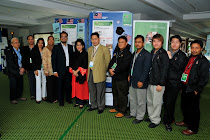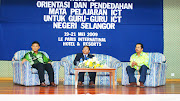A good teacher must have a good character, good attitudes, good teaching skills, and have a good relation with the students. The teacher must have a good teaching skill means that the teacher must make the students to understand easily what the teacher is teaching.
The teacher must be creative in order to make the students can easily understand or to make the study hours are enjoyable, so that the students are not bored. Rather than just speaking and explaining in front of the class, the teacher can also have some experiment or other fun activity like researching about weather to increase the student’s knowledge by doing something, not only by listening.
The teacher must also have a good relation with the students in order to know if the students can understand the teaching so that the teacher can do better.
●The most important in a good teacher is the desire to be a good teacher. This means the one who succeeds in every aspect of teaching, just like the teachers recognize students who really try to be good students, Students also recognize teachers who really want to be good teachers.
●A good teachers will always take risks. Sometimes, teachers that do not take a risk was not respected by the students so that the teacher can’t teach the student.
●A good teacher must have a positive attitude. Teacher who falls into the trap of bad attitude will never be positive about teaching. Good teachers meet all challenges with a positive attitude.
●A good teachers never have enough time and never finish their work, but a good teacher don't complain about the long hours because they love what they do.
●A good teachers think of teaching as a form of parenting. Teacher use the principles of good parenting in many times, including caring about their Students, knowing when to be firm to the students, and apologizing when it is needed. Good teachers, like good parents, know the students'' problems, and the students’ potential.
● A good teachers give their students a confidence. A good teacher realize that what the students learn is less important than the learning process by the teacher.
●A good teacher able to keep his or her students in balance. The students that are not active in class are a bored students. A creative teachers force their learning when their students try new techniques and introduce risks.
●A good teachers will always try to motivate students by working within their own learning system. Teachers who know their students' likes, dislikes, problems and personal issues are more likely to be able to motivate students to learn.
● A good teacher must be creative. The creative teacher also force a learning of knowledge. In a technical field like health care, teachers should be interested in more than just what students know. A creative teacher will be an active teacher. This means that the teacher will not only explain something in the class, but with some experiment or some project to do to increase students’ knowledge.
● A good teacher must have a good characteristic. This means the teachers’ ability to work together with students and treat them as partners.
● A good teacher must be caring. One of the part of caring is trust. For good teachers, one way to build trust is by allowing students to get to know them. Teachers who share about themselves give their students an appreciation for their knowledge. Teachers can also involve students in discussion groups and professional activities.
More About : what should a good teacher be like?
Visit this site : http://www.shvoong.com/books/1733641-good-teacher/
Tuesday, February 22, 2011
What Should A Good Teacher Be Like?
Posted by Zahri HjRamlan at 9:44 PM 0 comments
Sunday, February 20, 2011
Learning Theories and Teaching Strategies
# Experiential Learning
Definition: Teachers provide opportunities for real-world experiences based on students' prior knowledge.
Rationale: Brain-based research suggests that students who engage in real world experiences will attain and assimilate information effectively because the activities are meaningful in their day-to-day life experiences.
# Direct Instruction
Definition: A highly structured, teacher-centered information delivery method that may rely on drills, repetition, and scripted materials.
Rationale: Provides the teacher with a framework to impart information.
# Social Learning
Definition: Teacher-guided cooperative learning that facilitates student interaction.
Rationale: Strengthens students' ability to retain information through social interaction involved with cooperative learning within socially appropriate norms.
# Problem-based Learning
Definition: Teacher/student initiated inquiries that promote critical thinking and problem solving.
Rationale: Develops student ability to problem solve and think critically.
# Constructivist Instruction
Definition: Teachers apply brain research results and extend student learning by building on students' prior knowledge.
Rationale: The context in which an idea is taught as well as students' beliefs and attitudes affect learning.
# Thematic Instruction
Definition: Teachers provide cross-curricular learning on a central theme.
Rationale: Students are able to make coherent connections among disciplines and acquire an integrated knowledge base.
# Non-graded, Multi-age
Definition: Teachers implement curriculum based on students' individual learning progress rather than grade level.
Rationale: Students' chronological age and mental age do not always correspond. In a multi-age program students develop self-direction, responsibility, tolerance for others, social skills, self-assuredness, and positive attitudes toward learning and school.
# Multiple Intelligences
Definition: This theory, developed by Howard Gardner, suggests that intelligence based on IQ testing alone is far too limited; therefore, he proposed eight different intelligences to account for a broader range of human potential.
Rationale: It identifies students' abilities in other areas of intelligence and does not limit intelligence to strength in the logical-mathematical and linguistic areas.
# Miscellaneous Instructional Ideas
Definition: A list of ideas designed to stimulate teachers' thoughts and assist in expanding lesson plans.
Rationale: It provides a resource for the busy, time-challenged teacher.
# Additional Learning Theories
Definition: Some other generally accepted theories of learning with resource connections. This list is by no means exhaustive.
Rationale: Justice to all learning theories is not possible due to the vast number. This link supplies information on additional theories
Please visit this site for more info :
http://www.journeytoexcellence.org/practice/instruction/theories/
Posted by Zahri HjRamlan at 2:33 AM 0 comments










